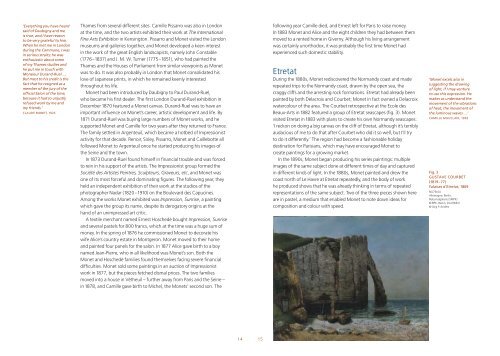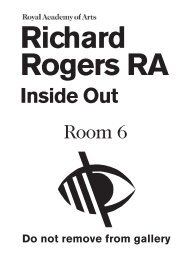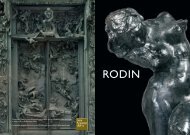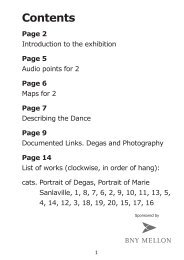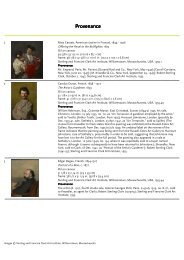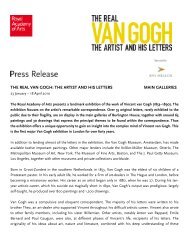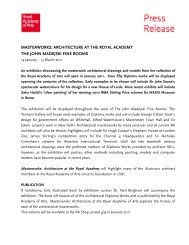Introduction to the Unknown Monet - Royal Academy of Arts
Introduction to the Unknown Monet - Royal Academy of Arts
Introduction to the Unknown Monet - Royal Academy of Arts
Create successful ePaper yourself
Turn your PDF publications into a flip-book with our unique Google optimized e-Paper software.
‘Everything you have heard<br />
said <strong>of</strong> Daubigny and me<br />
is true, and I have reason<br />
<strong>to</strong> be very grateful <strong>to</strong> him.<br />
When he met me in London<br />
during <strong>the</strong> Commune, I was<br />
in serious straits; he was<br />
enthusiastic about some<br />
<strong>of</strong> my Thames studies and<br />
he put me in <strong>to</strong>uch with<br />
Monsieur Durand-Ruel …<br />
But most <strong>to</strong> his credit is <strong>the</strong><br />
fact that he resigned as a<br />
member <strong>of</strong> <strong>the</strong> jury <strong>of</strong> <strong>the</strong><br />
<strong>of</strong>ficial Salon <strong>of</strong> <strong>the</strong> time,<br />
because it had so unjustly<br />
refused work by me and<br />
my friends.’<br />
CLAUDE MONET, 1925<br />
Thames from several different sites. Camille Pissarro was also in London<br />
at <strong>the</strong> time, and <strong>the</strong> two artists exhibited <strong>the</strong>ir work at The International<br />
Fine <strong>Arts</strong> Exhibition in Kensing<strong>to</strong>n. Pissarro and <strong>Monet</strong> visited <strong>the</strong> London<br />
museums and galleries <strong>to</strong>ge<strong>the</strong>r, and <strong>Monet</strong> developed a keen interest<br />
in <strong>the</strong> work <strong>of</strong> <strong>the</strong> great English landscapists, namely John Constable<br />
(1776–1837) and J. M. W. Turner (1775–1851), who had painted <strong>the</strong><br />
Thames and <strong>the</strong> Houses <strong>of</strong> Parliament from similar viewpoints as <strong>Monet</strong><br />
was <strong>to</strong> do. It was also probably in London that <strong>Monet</strong> consolidated his<br />
love <strong>of</strong> Japanese prints, in which he remained keenly interested<br />
throughout his life.<br />
<strong>Monet</strong> had been introduced by Daubigny <strong>to</strong> Paul Durand-Ruel,<br />
who became his first dealer. The first London Durand-Ruel exhibition in<br />
December 1870 featured a <strong>Monet</strong> canvas. Durand-Ruel was <strong>to</strong> have an<br />
important influence on <strong>Monet</strong>’s career, artistic development and life. By<br />
1871 Durand-Ruel was buying large numbers <strong>of</strong> <strong>Monet</strong> works, and he<br />
supported <strong>Monet</strong> and Camille for two years after <strong>the</strong>y returned <strong>to</strong> France.<br />
The family settled in Argenteuil, which became a hotbed <strong>of</strong> Impressionist<br />
activity for that decade. Renoir, Sisley, Pissarro, Manet and Caillebotte all<br />
followed <strong>Monet</strong> <strong>to</strong> Argenteuil once he started producing his images <strong>of</strong><br />
<strong>the</strong> Seine and <strong>the</strong> <strong>to</strong>wn.<br />
In 1873 Durand-Ruel found himself in financial trouble and was forced<br />
<strong>to</strong> rein in his support <strong>of</strong> <strong>the</strong> artists. The Impressionist group formed <strong>the</strong><br />
Société des Artistes Peintres, Sculpteurs, Graveurs, etc, and <strong>Monet</strong> was<br />
one <strong>of</strong> its most forceful and dominating figures. The following year, <strong>the</strong>y<br />
held an independent exhibition <strong>of</strong> <strong>the</strong>ir work at <strong>the</strong> studios <strong>of</strong> <strong>the</strong><br />
pho<strong>to</strong>grapher Nadar (1820 –1910) on <strong>the</strong> Boulevard des Capucines.<br />
Among <strong>the</strong> works <strong>Monet</strong> exhibited was Impression, Sunrise, a painting<br />
which gave <strong>the</strong> group its name, despite its deroga<strong>to</strong>ry origins at <strong>the</strong><br />
hand <strong>of</strong> an unimpressed art critic.<br />
A textile merchant named Ernest Hoschedé bought Impression, Sunrise<br />
and several pastels for 800 francs, which at <strong>the</strong> time was a huge sum <strong>of</strong><br />
money. In <strong>the</strong> spring <strong>of</strong> 1876 he commissioned <strong>Monet</strong> <strong>to</strong> decorate his<br />
wife Alice’s country estate in Montgeron. <strong>Monet</strong> moved <strong>to</strong> <strong>the</strong>ir home<br />
and painted four panels for <strong>the</strong> salon. In 1877 Alice gave birth <strong>to</strong> a boy<br />
named Jean-Pierre, who in all likelihood was <strong>Monet</strong>’s son. Both <strong>the</strong><br />
<strong>Monet</strong> and Hoschedé families found <strong>the</strong>mselves facing severe financial<br />
difficulties. <strong>Monet</strong> sold some paintings in an auction <strong>of</strong> Impressionist<br />
work in 1877, but <strong>the</strong> pieces fetched dismal prices. The two families<br />
moved in<strong>to</strong> a house in Vé<strong>the</strong>uil – fur<strong>the</strong>r away from Paris and <strong>the</strong> Seine –<br />
in 1878, and Camille gave birth <strong>to</strong> Michel, <strong>the</strong> <strong>Monet</strong>s’ second son. The<br />
14<br />
15<br />
following year Camille died, and Ernest left for Paris <strong>to</strong> raise money.<br />
In 1883 <strong>Monet</strong> and Alice and <strong>the</strong> eight children <strong>the</strong>y had between <strong>the</strong>m<br />
moved <strong>to</strong> a rented home in Giverny. Although his living arrangement<br />
was certainly unorthodox, it was probably <strong>the</strong> first time <strong>Monet</strong> had<br />
experienced such domestic stability.<br />
Etretat<br />
During <strong>the</strong> 1880s, <strong>Monet</strong> rediscovered <strong>the</strong> Normandy coast and made<br />
repeated trips <strong>to</strong> <strong>the</strong> Normandy coast, drawn by <strong>the</strong> open sea, <strong>the</strong><br />
craggy cliffs and <strong>the</strong> arresting rock formations. Etretat had already been<br />
painted by both Delacroix and Courbet; <strong>Monet</strong> in fact owned a Delacroix<br />
watercolour <strong>of</strong> <strong>the</strong> area. The Courbet retrospective at <strong>the</strong> Ecole des<br />
Beaux-<strong>Arts</strong> in 1882 featured a group <strong>of</strong> Etretat seascapes (fig. 3). <strong>Monet</strong><br />
visited Etretat in 1883 with plans <strong>to</strong> create his own Normandy seascapes:<br />
‘I reckon on doing a big canvas on <strong>the</strong> cliff <strong>of</strong> Etretat, although it’s terribly<br />
audacious <strong>of</strong> me <strong>to</strong> do that after Courbet who did it so well, but I’ll try<br />
<strong>to</strong> do it differently.’ The region had become a fashionable holiday<br />
destination for Parisians, which may have encouraged <strong>Monet</strong> <strong>to</strong><br />
create paintings for a growing market.<br />
In <strong>the</strong> 1890s, <strong>Monet</strong> began producing his series paintings: multiple<br />
images <strong>of</strong> <strong>the</strong> same subject done at different times <strong>of</strong> day and captured<br />
in different kinds <strong>of</strong> light. In <strong>the</strong> 1880s, <strong>Monet</strong> painted and drew <strong>the</strong><br />
coast north <strong>of</strong> Le Havre at Etretat repeatedly, and <strong>the</strong> body <strong>of</strong> work<br />
he produced shows that he was already thinking in terms <strong>of</strong> repeated<br />
representations <strong>of</strong> <strong>the</strong> same subject. Two <strong>of</strong> <strong>the</strong> three pieces shown here<br />
are in pastel, a medium that enabled <strong>Monet</strong> <strong>to</strong> note down ideas for<br />
composition and colour with speed.<br />
‘<strong>Monet</strong> excels also in<br />
suggesting <strong>the</strong> drawing<br />
<strong>of</strong> light, if I may venture<br />
<strong>to</strong> use this expression. He<br />
makes us understand <strong>the</strong><br />
movement <strong>of</strong> <strong>the</strong> vibrations<br />
<strong>of</strong> heat, <strong>the</strong> movement <strong>of</strong><br />
<strong>the</strong> luminous waves …’<br />
CAMILLE MAUCLAIR, 1903<br />
Fig. 3<br />
GUSTAVE COURBET<br />
(1819–77)<br />
Falaises d’Etretat, 1869<br />
NG76/44<br />
Allemagne, Berlin,<br />
Nationalgalerie (SMPK)<br />
© BPK, Berlin, Dist RMN /<br />
© Jörg P. Anders


